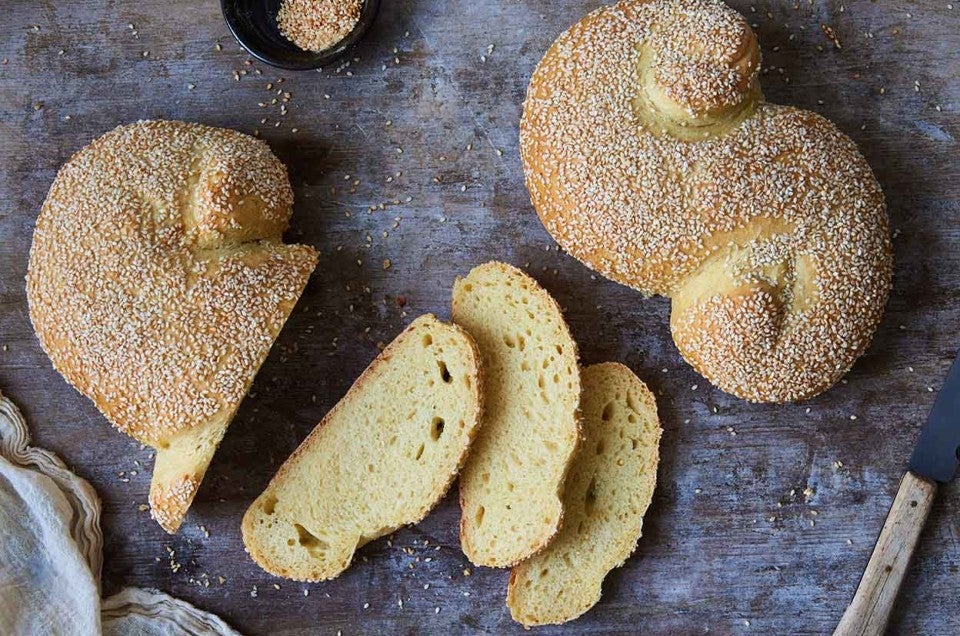


Most of us bake alone. Some of us bake with friends. But what an experience, to bake with a whole group of friends. Hands in dough, mixers whirring, sugar and flour and butter and vanilla and chocolate at your fingertips, lots of oven space...
That's the Baking Education Center (BEC) at King Arthur Flour here in Norwich, Vermont.
We have classes most days of the week. Classes for adults, for kids, for parents and kids together, for professionals... King Arthur's mission is to teach the world to bake. And so far, so good—we're currently the largest educator of home bakers in the world.
Hands-on classes vary in size from about 6 to 12 people. One recent bread, soup, and dessert class had 10 students—some of whom came with a friend, some of whom soon “buddied up” with the baker next to them. You never bake alone at King Arthur Flour.
That class started with Sesame Semolina Lunettas. Next, Shaker Chicken and Noodle Soup. The dessert: Quick Pots de Crème.
Planning a trip to Vermont? If not—maybe you should! Take a look at what we're offering this spring at our Baking Education Center.
And if you can't get to Vermont, find a baking buddy and bake some Sesame Semolina Lunettas for a virtual trip to our school.
Yeast bread is basically, flour, yeast, salt, and water. But little ingredient tweaks along the way can change that basic bread in subtle by very appealing ways. Take semolina, for instance. This cornmeal lookalike is actually a coarsely ground “flour” made from high-protein durum wheat. When used to replace some (or all) of the all-purpose or bread flour in your recipe, it imparts creamy color to the finished loaf, plus the barest amount of added crunch in the crust. I like to use it in pizza crust as well as bread.
And what about diastatic malt? Its active enzymes help yeast grow fully and efficiently throughout the fermentation period. Professional bakers use it to enhance bread's texture and improve its shelf life. Again, it's subtle... but you'll see the results below. Rather surprising results, actually.
Oh, and one more thing: NON-diastatic malt is a sweetener, particularly suited for pancakes and bagels. Don't confuse it with diastatic malt, as it doesn't have the same effect on yeast.
We'll start by putting semolina, King Arthur Unbleached All-Purpose Flour, instant yeast, salt, and diastatic malt in a mixing bowl.
Next, water and olive oil. Or, for added sesame flavor, toasted sesame oil.
Mix till well combined. The dough will be rough looking.
Switch to the dough hook, and knead for 6 minutes; this develops the gluten, allowing it to capture carbon dioxide from the growing yeast. Result? Dough that rises. Without the structure that gluten provides, the dough would leak CO2 like a sieve, and sit there like an inert blob rather than rising.
Oh, by the way: how do you like the way this dough shaped itself into a faux roasting chicken?
I decided to test the diastatic malt by making two batches of dough side by side. The one on the left has malt; the one on the right doesn't. Let's see what happens.
Ninety minutes later—holy mackerel, the dough with the malt certainly did rise higher.
Every time I stop by our Baking Education Center, I learn some cool new thing. This time, it was a simple “S” shape that makes a very pretty loaf—in Italian baking, a lunetta. So, I rolled the dough into an 18” log, and curled one end towards the center.
Then I did the same with the other end, making a tucked-in “S.”
Here are my two loaves side by side—the one with diastatic malt at the top of the picture.
Once the bread is risen, you'll brush it with egg white whisked with water. Why whisk it with water? To make it spreadable; without water, it's awfully gluey.
Brush on the risen loaves...
...then sprinkle with sesame seeds.
Why wait for the loaves to rise before adding the seeds? Because if you add them before the loaves rise, you'll get a sparser effect; the rising dough pushes the seeds away from one another, allowing more crust to show through.
By the way, during rising the loaf with the malt had become a bit more puffy than the loaf without malt.
And here they are, baked. The loaf without the malt (on the right) didn't brown quite as well, though the difference was slight. Which makes sense, since diastatic malt converts starch to sugar, and sugar promotes browning. And, the loaf without malt didn't rise quite as high. At the end of the day, the loaf with malt simply looked better.
My verdict? Diastatic malt isn't critical, but if you're a dedicated bread baker who likes a really nice-looking result, get some and fool around with it.
Check out our Baking School classes if you'd like to come visit us for the real thing!

